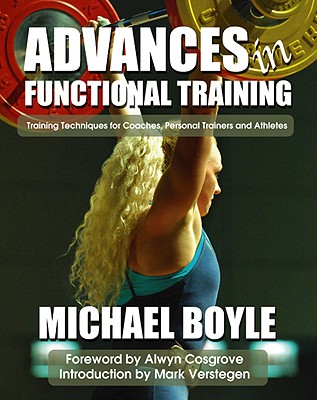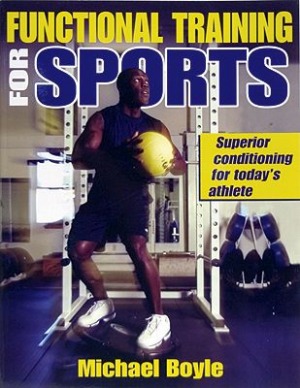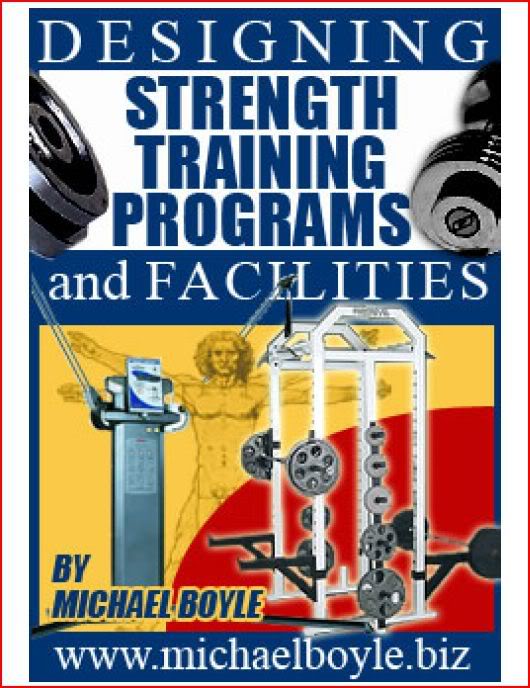Damn you Kindle your portability and way cheaper books! Damn You…..
Actually, it’s really awesome. After I finished Never let Go by Dan John, review (which was picked up and put out on Dan John’s email blast) here, I picked up Mike Boyle’s latest book Advance in Functional Training. It’s the third book Mike Boyle has put out and it is BY FAR the best.
The first book Functional Training for Sports was one of the very first books on training I ever bought and at the time a seminal “pick up and apply” book in the field. You could buy the book read it in a couple of days, understand or at least apply the concepts and you would be better off than most of the people out there. For the average guy coaching his kids team or even most high school coaches this book was probably a godsend and resulted in some kids getting a pretty good training response. But there were two problems with this book….
One: The Cover
Even coach Boyle himself has said that he wished they didn’t put that (the guy on the wobble board) on the cover because it gives a misconception of what “functional training” is actually about.
Two: The people who bought it. (It’s the one of the three most meant for the consumer market)
This book has a lot of good info in the first part of the book, warmups, exercise selections, progressions, how to set up a program etc. Actually, that’s most of the book. But in the last little part there are actual EXAMPLE programs.
There in lies the problem, parents and coaches. I helped out with some area hockey teams a few years ago and literally in both situations I was given what they were currently doing for a training program it was straight out of the back of the book. Literally, exercise for exercise, rep for rep, set for set…exactly the same only with a different team name at the top.
How could two organizations with different levels and ages of players use exactly the same protocol? Seems strange to me too. Fact was, no one ever read the book, they went straight to the back and pulled an EXAMPLE workout. Never mind assessment or progression….
Book two, Designing Strength Training Programs and Facilities was not geared toward the average person. It’s really good information (although a little old now) especially on the design end.
The book I just finished Advances in Functional Training is the newest and best of the three. This book is a comprehensive overview of what they do at MBSC (Mike Boyle Strength and Conditioning). It goes over every aspect of the training process from assessments, warmups, progressions, to entire program templates.
The best part of this book is the rationalization that coach Boyle provides for everything. I can’t think of any part of the programming that is not thought out. It’s obvious that the programming is different from what he was doing when Functional Training or Designing Programs was printed.In many cases throughout the book Boyle explains why they have changed the programming. Typically it goes something like this, “we changed because Gray Cook, Stuart McGill, Shirley Sahrmann did research and said this was better, I thought about it and it made sense, we tried it and it worked”…..
As far as I’m concerned that’s pretty good reasoning.
Basically this book comes down to this:
To me, function is essentially purpose. Functional training can therefore be described as purposeful training……..What functional training really comes down to is the application of functional anatomy to training. It is taking what we know and using that information to select exercises to reduce the incidence of injury and improve performance.
This book has a wealth of information in it from start till finish…in fact I think it may be the best Strength and Conditioning book I’ve bought in the last 2-3 years. The chapters on injuries, the core and the hips are PACKED with information which would cover the cost of the book by themselves. It’s far too expansive to cover every aspect here but take my word, if you design programs and train people you’ll pick up lots of useful strategies and progressions as well as seriously question some of your current exercise selections and program designs.
Things like:
Why brace vs. draw in
brace (mostly)
Why single leg exercises.
Less back compression. works the intrinsic musculature more (injury prevention)
What are the common dysfunctions and causes of injuries.
Tight hips, under active glutes, locked up thoracic spine = bad back
How to group training means (exercise selection) and plan out a training week.
Hip vs. Knee dominant, pulling and pressing, CNS intensive training
What to assess and more importantly what that assessment means for training.
FMS, where to start athletes with poor scores quadruped, tall kneeling etc..
Equipment choices: best bang for the buck.
Trx, slideboards, sleds etc..
It’s $10 for the Kindle @ Amazon. Go buy it.





